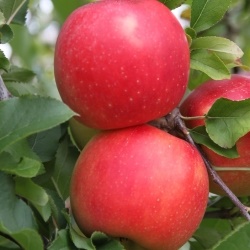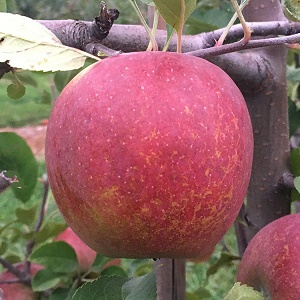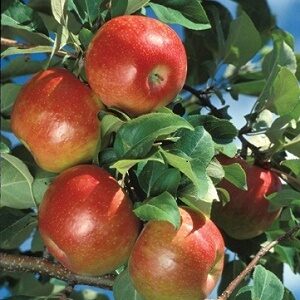Apple (Malus)
One of the most challenging fruits to grow organically, but take heart! Choosing one of our scab resistant varieties is a good start. With the vast array of flavours available (even for colder regions) in this healthy, versatile fruit, it would be a shame not to try a few trees. Natural pest control with insect traps and kaolin clay sprays can be used if desired. However, apples that are less than picture perfect are still just as flavourful and nutritious. Even with insect damaged fruit all is not lost. Drying, juicing or making apple sauce are still great options. Remember the old adage ‘an apple a day keeps the doctor away’ was coined before the days of pesticide sprays.
1-2m (3-6') bareroot trees
Apple : KINDERKRISP Large Semi-Dwarf (B118)
$49.95
Although Honeycrisp remains a force to be reckoned with in the apple world, some of it's easier-to-grow progeny aspire to attain equal prominence. One of the newest, next-generation varieties is KinderKrisp, developed by David MacGregor in Minnesota. Exhilarating Honeycrisp texture combined with exceptional flavour endears this perfect snack to kids of all ages. Cute, child-size, rosy red apples are tops for packed lunches. They ripen right at the start of the school year and will hang on the tree for an extended period.
NEEDS A POLLENIZER | ZONE 3/4 | HARVEST: LATE AUG.-EARLY SEPT.
Rootstocks
G41 Dwarf
(2.5-3.1m/8-10ft)
G935 Small Semi-Dwarf
(3.25-4m/10-13ft)
G969 Small Semi-Dwarf
(3.25-4m/10-14ft)
G30 Semi-Dwarf
(3.6-5m/12-16ft)
G890 Semi-Dwarf
(3.6-5m/13-16ft)
Pollenator definitions
Some trees and many berry plants are SELF-FERTILE ̶means the insect pollinators or even the wind can pollinate the blossoms without the need of a second tree.
NEEDS A POLLENIZER ̶ means another tree of the same type or kind but a different variety must be blooming nearby at the same time.
EXAMPLE A Liberty apple and a Wealthy apple can cross-pollinate. Two trees of the same variety ie: ̶ 2 Wealthy apples, cannot cross pollinate because they are genetically identical.
Other trees are marked as SEMI-FERTILE. These will set fruit without a second tree. However they will often bear more, and sometimes larger fruit if another variety of the same kind of tree is nearby.
You can select 2 different trees of the same kind marked as NEEDS A POLLENIZER or plant one of those along with one SELF-FERTILE or one SEMI-FERTILE. Also consider ripening times ̶ a Goldrush apple might not start blooming before a Pristine is finished.
NEEDS A POLLENIZER ̶ means another tree of the same type or kind but a different variety must be blooming nearby at the same time.
EXAMPLE A Liberty apple and a Wealthy apple can cross-pollinate. Two trees of the same variety ie: ̶ 2 Wealthy apples, cannot cross pollinate because they are genetically identical.
Other trees are marked as SEMI-FERTILE. These will set fruit without a second tree. However they will often bear more, and sometimes larger fruit if another variety of the same kind of tree is nearby.
You can select 2 different trees of the same kind marked as NEEDS A POLLENIZER or plant one of those along with one SELF-FERTILE or one SEMI-FERTILE. Also consider ripening times ̶ a Goldrush apple might not start blooming before a Pristine is finished.
Other products in this zone
Growing Tips
Apple Growing Tip
Besides selecting the most disease resistant varieties, there are
a few simple things to do to have better apples.
- Fertilize under the outer edges of your trees. There are no feeder roots next to the trunk. A well fed tree stays healthier. (Adequate calcium in the soil also helps so that apples keep longer.)
- Pick up fallen fruit and compost, dispose of, or feed to livestock (where possible).
- Rake up leaves in the fall and compost them away from the orchard.
- Prune trees to encourage light and air to reach the inside of the tree.
- Provide bird nesting sites near your orchard. A variety of orchard companion type plants will attract native pollinator insects and also encourage birds to come and eat insect pests.








